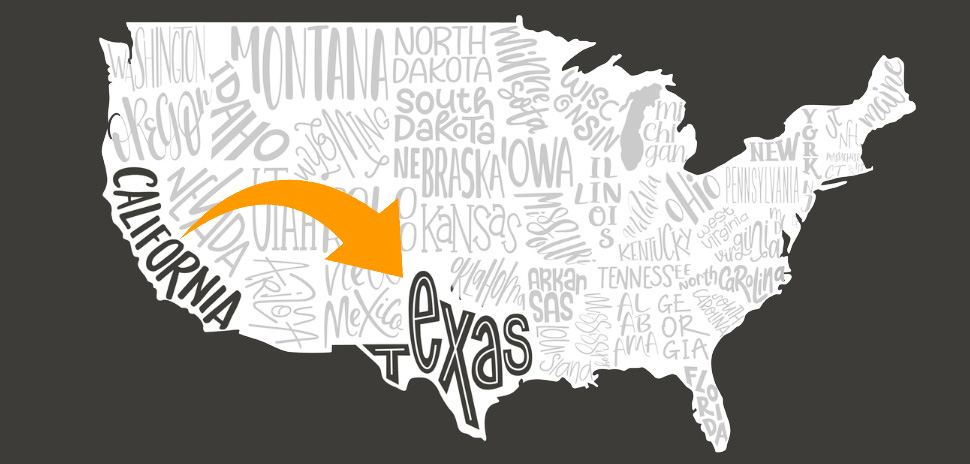As some Californians set their sights on new horizons, they continue to swap their Pacific sunsets for Texas sunrises. A new report dissects a noticeable migratory trend of Californians to the Lone Star State—including the increasing allure of North Texas.
In an era filled with a steady stream of reports and surveys, it can be challenging to discern the signal from the noise. StorageCafe, a sister division of research firm Yardi Matrix, has focused its latest insights into the motivations, demographics, and economic impacts of what it calls a “Texodus.”
According to StorageCafe, migration from California to Texas has emerged as the leading interstate relocation route in the U.S.
‘Texodus’ route is crowding up
“Not only is Texodus not slowing down, but the route is getting more crowded, increasing by a whopping 80% in 2021 compared to figures from a decade before,” Yardi told Dallas Innovates.
In 2021, about 111,000 people made the move from California to Texas. To put that in perspective, if all the Californians moving in one year to the Lone Star State formed their own city it would be close to the size of Richardson, Carrollton, or Frisco in North Texas.
Migrating millennials
Notably, millennials were a significant portion of those migrating, accounting for around half of the California to Texas migrations, StorageCafe reports.
According to the study, those millennials have an above-average annual household income of $114,000. That figure surpasses the national average income for millennials by 21%, which stands at $94,000 per year.
The migrating millennials are setting their sights on counties anchored by Dallas, Austin, and Houston. The appeal of these Texas destinations for migrating millennials lies in the promising job prospects across industries such as technology, finance, education, and healthcare, StorageCafe notes.
Per the study, among the various migration routes, Santa Clara to Dallas County stood out as the most financially advantageous for homebuyers, offering substantial savings with a 258% difference in listing prices ($410,000 in Dallas County vs. $1,467,000 in Santa Clara). That’s a savings of more than $1 million.
The migration isn’t a one-way street, the researchers point out. In 2021, some 33,000 Texans made California their home. But “Texans tend to move to California in much smaller numbers,” according to StorageCafe.
Getting more for your housing dollar
The study’s analysis draws from the IPUMS Survey Documentation and Analysis (SDA) tool, which provides integrated census and survey data, according to StorageCafe. The IPUMS data, collected by the Institute for Social Research and Data Innovation at the University of Minnesota, offers a foundation for the study’s findings. It also incorporates data from Yardi Matrix, Point2, and The Cost of Living Index published by the Council for Community and Economic Research (C2ER).
Doug Ressler, business intelligence manager at Yardi Matrix, sheds light on the migration trend to Texas, noting that inflation and financial strain due to rising expenses are driving migration patterns. Many individuals are seeking more affordable places to live, leading them to cross city and state lines in search of suitable options.
“Migration patterns are closely connected to the dynamics of the economy in the post-pandemic world,” he said in a statement. As inflation continues to be a concern for people, “moving to places that are easier on the wallet seems like the obvious solution, with many people crossing city and state lines to find a more suitable place to live.”
“California is now a regular exporter of people, particularly to Texas”
Professor Rogelio Saenz from the University of Texas at San Antonio also highlighted the rising trend of Californians moving to Texas. “California is now a regular exporter of people, particularly to Texas,” he said in a StorageCafe Q&A, noting that the increased feasibility of remote work during the pandemic has led to many people, especially from high-cost cities like Los Angeles and San Francisco, seeking more affordable living conditions in Texas.
Texas has received more interstate migrants from California than any other state throughout the 20th century, according to Saenz. The professor cited American Community Survey data indicating a 36% increase in the number of Californians moving to Texas between 2016 and 2021 and pinpointed steep housing prices and high cost of living in California as the primary driving factors for this trend.
According to Saenz, people relocating from California to Texas are typically young, with a median age of 29, and often well-educated. The demographic breakdown suggests that these migrants are predominantly white and Asian, although Latino and Black Californians also constitute a substantial portion.
Top report takeaways
Yardi’s Ressler noted that Dallas County was among the top three counties in Texas to see the highest number of newcomers in 2021, with around 45,000 people moving in. Harris County led the way with approximately 69,000 arrivals, followed by Bexar County with 48,000.
He said most of the newcomers in all three counties were from California.
In terms of percentage of population increase, North Texas’ Kaufman County (7.5%), was among the three leading counties along with Garza County (7.8%) and Comal County (6.9%), Ressler said.
Preliminary data from the U.S. Census Bureau’s 2022 estimates also included Kaufman, along with Rockwall and Parker counties, among those with the greatest population gains compared to 2021.
The summary analysis of North Texas counties shows:
- In 2021, around 25,000 Californians moved to Dallas, Tarrant, Collin, and Denton counties in North Texas. That ranks all these North Texas counties among the state’s top 15 destinations for Californians. Los Angeles County was the “main supplier” of new residents, followed by the Orange and San Diego counties.
- One key reason for the move is that housing in North Texas is 80% cheaper than in Los Angeles. This leads to a price gap of about $392,000.
- Rent in Texas is generally over 50% cheaper than in California, except for those moving from LA to Collin County.
- Moving from Los Angeles to Collin County gives the most extra space: over 1,000 sq. ft. more for homeowners and 124 sq. ft. more for renters.
- Homes in Texas are typically 17% larger than those in California. Apartments are around 6% larger.
Report: Two Calif.-to-Texas moving routes can result in savings of over $1M
Buying a house in Dallas instead of San Jose can save a transplant more than $1M on average. This is because houses in Dallas are 258% cheaper than those in Santa Clara, the study says.
The next significant price difference is between San Mateo and Travis counties, with a 243% difference. This could save homebuyers almost $1.3M on average, according to StorageCafe.
But as Professor Saenz points out, the influx of Californians has inadvertently contributed to rising house prices in Texas.
While Texas housing remains significantly more affordable than in California, the state has seen a 30% increase in median home value between 2016 and 2021, with Californian transplants living in homes of higher value than native Texans and migrants from other states.
Potential renter savings of more than $1,000 a month
Living affordably in Texas’s top 25 destinations is possible for renters, the study says. Renters don’t have to spend more than 25% on rent, except for those moving from San Diego to Dallas.
Overall, the data show that rent is cheaper in Texas compared to California, based on median rent data. For example, moving from Santa Clara to Dallas County could save $1,472, with the rent drop from $3,034 to $1,562. Similarly, moving from San Diego to Tarrant Country can save $1,238, as rent drops from $2,683 to $1,445.
Moving from Los Angeles County to El Paso County could net the highest savings, with a 154% rent difference, saving about $1,580 monthly. The next big savings come from moving from San Diego to San Antonio, where renters can save around $1,470 per month due to a 110% rent difference.
In 18 moving routes highlighted in the study, people can save over $1,000 a month in Texas compared to their Californian county of origin.
In terms of size, moving from Orange County (with an average apartment size of nearly 870 square feet) to either Travis or Dallas counties in Texas can lead to a little less living space for renters, according to the research. On average, apartments in the two Texas counties provide about 860 square feet of space.
Homeowners go big in Texas
As previously noted, homes in Texas are 17% larger than those in California, while apartments in Texas are about 6% bigger.
Moving to either Collin or Denton counties in Texas from Los Angeles can provide substantial gains for people looking for more room. According to the study, moving from Los Angeles to Collin County could net the biggest gain in living space. Homeowners gain an extra 1,055 square feet, while renters get an additional 124 square feet.
A move from Los Angeles to Denton County could result in a 935 square foot increase in median home size.
Not surprisingly, the StorageCafe study also points out another impact of the migration trend in DFW: a booming self-storage market. Texas fares considerably better on the self-storage front, with over 10.3 square feet of storage space per person, the firm notes. California, on the other hand, is lagging with 6.3 square feet of storage space per capita. That substantial storage capacity highlights the response to the growing demand from individuals and families relocating to Texas—and aligns with the needs of newcomers.
Will the moving trend continue?
Professor Saenz anticipates that this migration trend is likely to continue due to the persistent disparity in housing prices and cost of living between California and Texas.
“Over the first two decades of the 21st century, the movement of people leaving California for Texas has been well established,” he said. “No other state has sent more migrants to Texas than California during this time. The continual soaring housing prices and cost of living in California and much greater affordability in Texas is likely to sustain the significant flows of Californians toward Texas in the coming decades.”
StorageCafe’s full study is available here:
![]()
Get on the list.
Dallas Innovates, every day.
Sign up to keep your eye on what’s new and next in Dallas-Fort Worth, every day.









































